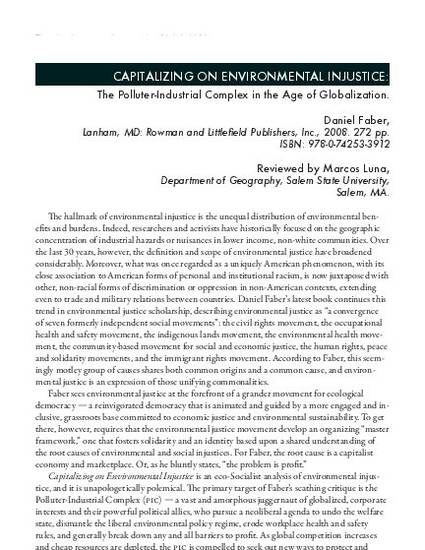
Article
Review of Capitalizing on Environmental Injustice: The Polluter-Industrial Complex in the Age of Globalization by Daniel Faber
The Northeastern Geographer
(2010)
Abstract
Te hallmark of environmental injustice is the unequal distribution of environmental benefits and burdens. Indeed, researchers and activists have historically focused on the geographic concentration of industrial hazards or nuisances in lower income, non-white communities. Over the last 30 years, however, the definition and scope of environmental justice have broadened considerably. Moreover, what was once regarded as a uniquely American phenomenon, with its close association to American forms of personal and institutional racism, is now juxtaposed with other, non-racial forms of discrimination or oppression in non-American contexts, extending even to trade and military relations between countries. Daniel Faber’s latest book continues this trend in environmental justice scholarship, describing environmental justice as “a convergence of seven formerly independent social movements”: the civil rights movement, the occupational health and safety movement, the indigenous lands movement, the environmental health movement, the community-based movement for social and economic justice, the human rights, peace and solidarity movements, and the immigrant rights movement. According to Faber, this seemingly motley group of causes shares both common origins and a common cause, and environ-mental justice is an expression of those unifying commonalities.
Disciplines
Publication Date
2010
Citation Information
Marcos Luna. "Review of Capitalizing on Environmental Injustice: The Polluter-Industrial Complex in the Age of Globalization by Daniel Faber" The Northeastern Geographer Vol. 2 (2010) p. 82 - 84 Available at: http://works.bepress.com/marcos-luna/55/
